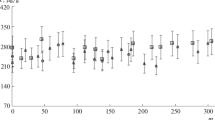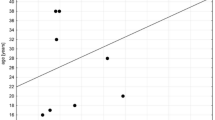Summary
Teeth from people aged 5–73 years old, who differ in their occupational type of exposure to lead and who live in different areas of Dortmund, were collected in 1980/81 and were investigated by means of flameless atomic absorption spectrometry. The major result obtained from the 163 permanent and 22 deciduous teeth studied was a statistically significant dependence of the lead content of the permanent teeth on the donor's age. This was superior to all other influences, showing an increase of 3.4% per year of life. There were no sex specific differences, and no correlations with height and body weight were found. To find different lead concentrations within samples of teeth of various living areas and various occupational types of exposure would have required more variation in these variables than was available in the population of our study. It must be emphasized that the reliability of the measured values of dental-lead concentration greatly depends upon the methodical and analytical procedures used, especially because of the overall lead contamination. The analytical method we finally used is described. The factors which influence the dental lead concentration are discussed. The investigation of whole teeth is tolerable. The age-dependent values of the lead content of teeth could be a useful indicator of the overall lead uptake especially in continuous low level lead exposure. Under the conditions described, at least 150 permanent teeth are needed to compare samples of different regions or periods.
Similar content being viewed by others
Literatur
Altshuller LF, Halak DB, Landing BJ, Kehoe RA (1962) Deciduous teeth as an index of body burden of lead. J Pediat 60:224–229
Brudevoll F, Aasenden R, Srinivasian BN, Bakhos Y (1977) Lead in enamel and saliva, dental caries and the use of enamel biopsies for measuring past exposure to lead. J Dent Res 56:1165–1171
Chatman, T, Wilson DJ (1975) Lead levels in human deciduous teeth in Tennessee. Environmental Letters 8:173
Ewers U, Brockhaus A, Winneke G, Freier I, Jermann E, Krämer U (1982) Lead in Deciduous Teeth of Children Living in a Non-ferrous Smelter Area and a Rural Area of the FRG. Int Arch Occup Environ Health 50:139–151
Fosse G, Beg Justensen NP (1978) Lead in deciduous teeth of Norwegian children. Arch Envir Health 33:166–175
Holtzman RB, Lucas HF, Ilcowicz FH (1970) The concentration of lead in human bone. Argonne National Laboratory Report, ANL 7615:43–49
Kaneko Y, Inamori I, Nishimura M (1974) Zinc, lead, copper, and cadmium in human teeth from different geographical areas in Japan. Bull Tokyo Dent Coll 15:233–243
Khandekar RN, Ashawa SC, Kelkar DN (1978) Dental lead levels in Bombay inhabitants. Sci Total Environ 10:129–133
Lappalainen R, Knuuttila M (1979) The distribution and accumulation of cadmium, zinc, lead, cooper, cobalt, nickel maganese, and potassium in human teeth from five different geological areas of Finland. Arch Or Biol 24:363–368
Lockeretz W (1975) Lead content of deciduous teeth of children in different environments. Arch Envir Health 30:583
Mackie AC, Stephens R, Townshend A, Waldron HA (1977) Tooth lead levels in Birmingham children. Arch Envir Health 32:178–185
MAGS Jahresberichte (1975–1981). Ministerium für Arbeit, Gesundheit und Soziales des Landes NW (Hrsg)
Malik SR, Fremlin JH (1974) A study of lead distribution in human teeth, using charged particle activation analysis. Caries Res 8:283–292
Moore MR, Campbell BC, Meredith PA, Beattie A, Goldberg A (1978) The association between lead concentrations in teeth and domestic water lead concentrations. Clin Chim Acta 87:77
Needleman HL, Tuncay OC, Shapiro IM (1972) Lead levels in deciduous teeth of urban and suburban American children. Nat 235:111–112
Rytömaa L, Tuompo H (1974) Lead levels in deciduous teeth. Nat 61:363
Sachs L (1971) Statistische Auswertungsmethoden. 3. Aufl. Springer, Berlin Heidelberg New York, S 342
Shapiro IM, Needleman HL, Tuncay OC (1972) The lead content of human deciduous and permanent teeth. Environ Res 5:467–470
Steenhout A, Pourtois M (1981) Lead accumulation in teeth as a function of age with different exposures. Br J Ind Med 38:297–303
Stephens R, Waldron HA (1976) Body burdens of lead in Birmingham. Conference of Royal Society of Health on Lead in the Environment, Birmingham, March 18th
Stewart DJ (1974) Teeth as indicators of exposure of children to lead. Arch Dis Child 49:895–897
Strehlow CD, Kneip TJ (1969) The distribution of lead and zinc in the human skeleton. Am Ind Hyg Ass 30:372–378
Strehlow CD (1971) The use of deciduous teeth as indicators of lead exposure. Doctoral Thesis, Institute of Environment Medicine, New York University Medical Center, New York
Wilkinson DR, Palmer W (1975) Lead in teeth as a function of age. Int Lab 67:41–46
Author information
Authors and Affiliations
Rights and permissions
About this article
Cite this article
Kollmeier, H., Seemann, J., Wittig, P. et al. Altersabhängige Kumulation von Blei in den Zähnen. Klin Wochenschr 62, 826–831 (1984). https://doi.org/10.1007/BF01711860
Received:
Revised:
Accepted:
Issue Date:
DOI: https://doi.org/10.1007/BF01711860




